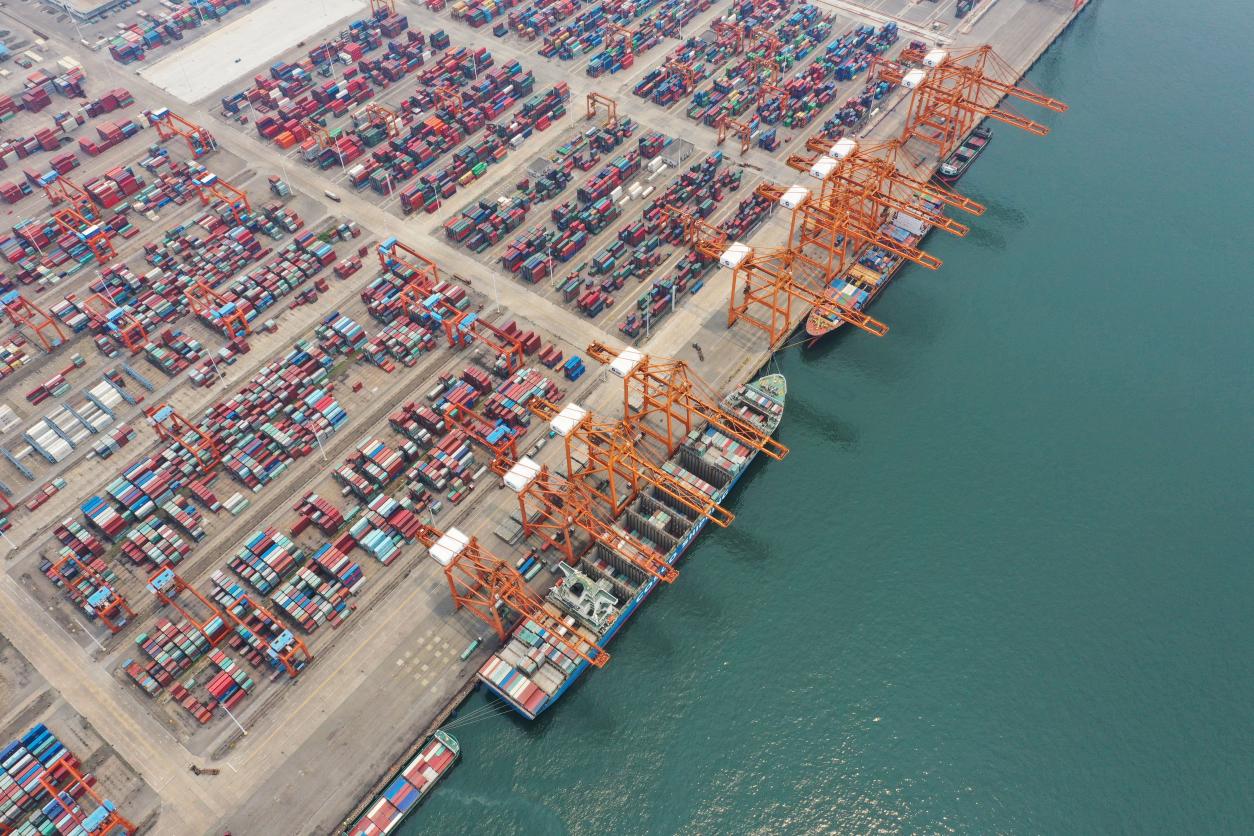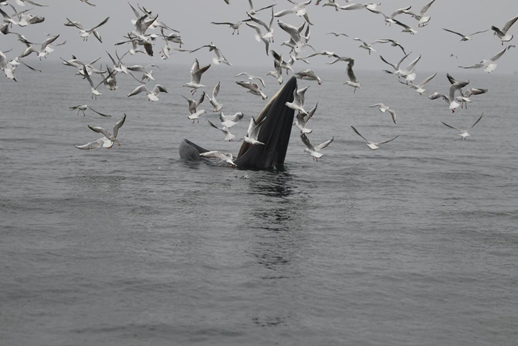

(Written by Guan Qiuyun / Translated by Xie Zongming)
As summer carelessly covers the Beibu Gulf, where the sea blends in with the sky at the far horizon, people on the shore are forging a new way into the ocean. At the wharf, countless freighters pass by each other. Giant cranes rotate in the howls of engines. At the construction site not far away, workers focus on their job with the fullness of passion. In the industrial parks, companies sing a chorus of work resumption, capacity expansion and innovation.
President Xi inspected Guangxi in April 2021, 4 years after his last visit. When hearing the report by Guangxi Party Committee and Guangxi government, he pointed out that Guangxi should be part of the construction of the Belt and Road Initiative and jointly develop the Land-Sea Freight Route in Western China with nearby provinces. The ocean lies the potential of Guangxi. Facing the new course of marine economy, Guangxi Beibu Gulf Economic Zone chooses to play as the vanguard of Guangxi.
Breakthrough in Guangxi’s marine economy
The freeway connecting Songwang and the east coast of Tieshan Harbor, invested and constructed by Guangxi Communications Investment Group, was open to traffic on Dec. 18th, 2020. The route efficiently reduces the travel time from Yulin city to Beihai’s Tieshan Harbor (Longtan) Cluster and East Harbor District of Tieshan, providing traffic infrastructure for Longtan Industrial Park in Yulin and connecting the east and west coast of Tieshan Harbor. This project promotes the development of the Beibu Gulf Economic Zone while being part of the construction of the Land-Sea Freight Route in Western China.
“This marks a new vein of Guangxi’s marine economy!” said Jing Dongping, Deputy Chairman of Guangxi Communications Investment Group. With this freeway opened, the transportation cost could be reduced by 6 yuan per ton, equivalent to an 80 million yuan per year cut in transportation cost for the enterprises, benefiting both the enterprises and the consumers.

Factors like the new freeway, functions as a traffic junction, and the favorable policies assigned as Beibu Gulf Port ascended to the top 10 coastal ports of China and become an international freighter hub, have made Beibu Gulf Port a preferred option. According to the data, the cargo throughput of Beibu Gulf Port reached 296,000,000 tons in 2020, a 15.64% growth on a year-on-year basis; container throughput reached 5,051,600 TEU, a year-on-year growth of 32.25%, which topped the list of growth among Chinese coastal ports. By May, 20th, 2021, Beibu Gulf Port has 271 bulk berths, 98 of which are for vessels of 10,000 or more tons and the maximum capacity for berthing is 300,000 tons. Meanwhile, the modernization of the port is keeping up, which improves the navigation capacity of the Xi River—Pearl River channel. This improvement further strengthens the connection between rivers and the sea, enhancing the construct of marine development.
With the fine port ready, the future of marine industries and the economy is at hand. As the attracted modern industries coming into a cluster, the port area will be the outpost of Guangxi’s marine economy.
Let’s take the modern fishery for example. The Oyster Farming Demonstration Area of Qinzhou Bay boasts its massive oyster farming. The oyster farming units in line stretch to the horizon. After 7 years of management, this oyster farm has become the biggest in China, making up for about 70% of Chinese estuarial oyster production. There are more than 100,000 local workers live on oyster-related industries in Qinzhou, making oyster farming the major fishery project of the city. People in Tieshan District, Beihai, on the other hand, seek resources from the deep ocean. The Demonstration Area of Deepwater Storm-Resistant fishery is located here. Fishers bring cage aquaculture to the deep ocean, creating the biggest cage aquaculture base among the three coastal cities (Qinzhou, Beihai, Fangchenggang), whose products are sold well in Guangdong, Fujian, Shanghai and countries in Southeastern Asia, Europe and America.
The petrochemical industry is another key industry of the Beibu Gulf Economic Zone. On the construction site of the Huayi Qinzhou Chemicals & New Materials Integration Base (Phase II), the piling of the solid waste treatment factory has just begun. Workers skillfully operate the giant machinery, playing a symphony of steel and cement. This base, with an investment of 70 billion yuan, is another eco-friendly high-end chemicals and new materials project serving ASEAN countries after the 10 million-level oil refining project invested by China National Petroleum Corporation.
Aside from these industries, a modern port-surrounding industries cluster, which centers around steel, non-ferrous metals and cereal & oil is forming. A group of projects by Liuzhou Steel Group and Guangxi Shenglong Metallurgical Co. Ltd are launched one after another.
“These industries are like pillars to the marine economy," said Huang Rukun, Counselor of the Development and Reform Commission of Guangxi. Currently, the three coastal cities are developing their distinctive yet coordinating leading industries. Together, these three cities are to make the Beibu Gulf a core region of Guangxi’s economic development.

Though the fast-growing industries might put pressure on the ecosystem, the Guangxi government has been keeping Xi’s guidance in mind, which is that Guangxi’s ecosystem is not to be bargained with. Thus, choosing a path of environmental-friendly, low-carbon, high-efficiency and recyclable development is one of the principles in promoting the marine economy.
Following this idea, the Guangxi government has put forward a series of policies such as the Marine Environment Protection Regulation of Guangxi Autonomous Region and the Marine Ecological Red Line Delineation Plan, for which the marine ecology is now better preserved. Up to May 20th, 2021, more than 90% of Guangxi’s nearshore seawater reached the top level of quality in the test, whose quality has been in China’s top 3 list for 8 consecutive years. Another example is in Beihai. Beihai National Wetland Park (Fengjia River Part)’s ecological protection and recovery project was highly appreciated by Lu Hao, Minister of China’s Ministry of Natural Resources, and was listed as a standard model of ecological recovery in China.
The promotion of the function as a traffic hub, the construction of the Beibu Gulf Port, the development of a marine industrial system and the recovery of marine ecology together, have shown the steady improvement in social, economic and ecological benefits as Guangxi’s “blue engine” is running steaming hot.
To become an advantaged coastal region in the “opening year”
2021 is the first year in the 14th Five-Year Plan, as well as a year of opportunities for Guangxi to develop the marine economy and to make use of its coastal advantage. But the question is, how may Guangxi further develop on top of the achievements gained so far? Or more specifically, how to push the marine economy to a more innovative, logical and modern direction? These are the questions of the decade and the concern of the people.
The press conference themed “Guangxi vigorously develops its marine economy, constructing itself into an advantaged coastal region” was held on May 20th, 2020. At the conference, Jiang Hesheng, Deputy Director-General of the Natural Resources Department of Guangxi and Director of Oceanic Bureau of Guangxi, stated the next step of marine economy development.
Guangxi Dafengjiang Bridge connects Beihai, Qinzhou and Fangchenggang
According to Jiang, the primary mission is to improve the area distribution of the sea and coordinate land economy and marine economy. The implements are to connect the advanced capital city strategy and the integration of three coastal cities strategy by utilizing marine economy as the bond between the two regions; to build a coastal economic region that owns complementary industries and cluster advantages, making the three coastal cities into the new leading factors of Guangxi’s high-quality development.
Second, the importance must be attached to the innovation in marine technology and the ability to transform the scientific results into productivity, so as to build a marine-tech innovation hub around the Beibu Gulf Economic Zone. What’s worth mentioning is that the 4th Institute of Oceanography, Ministry of Natural Resources is situated inside the Beihai Ocean Industry Technology Park, boosting Guangxi’s “Technology help develop marine industries” strategy. For example, the industrialized pearl farming in Nanzhu and the marine biomedical industry are sprouting in the park. The rough processing is replaced by deep processing with high added values given by technology. Marine industries with high-techs are gradually developing into the pilot of Guangxi’s “seaward” development.
Finally, ecological preservation and pollution control must be enhanced. Meanwhile, the ability of ecological recovery and disaster prevention and reduction must be improved, in order to reinforce the coastal eco-barrier. Only by keeping the ecosystem as they are, could the unique environmental advantages of Guangxi remain.
Back in the ancient days, Hepu Prefecture (currently located in Beihai city, Guangxi) was the very first departure port of Maritime Silk Road. Now, the Beibu Gulf Economic Zone combines the national strategy with its unique advantages, striving to create the “blue engine ” of the economy, boosting the marine economy to a new stage.
桂ICP备14000177号 Copyright@2006-2013 Guangxi China-ASEAN Panorama Magazine Agency Co., Ltd. All Rights Reserved